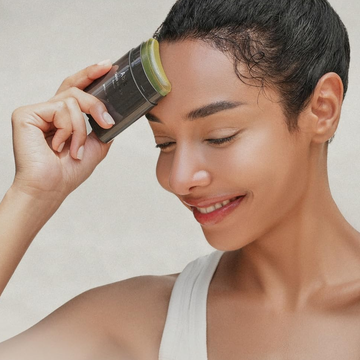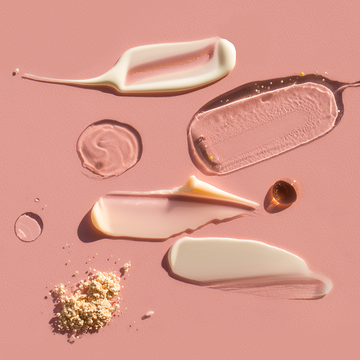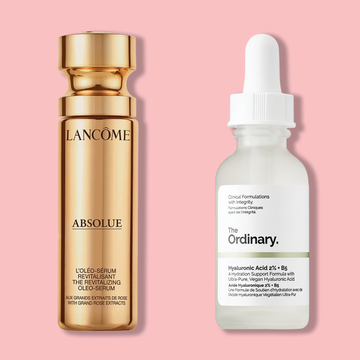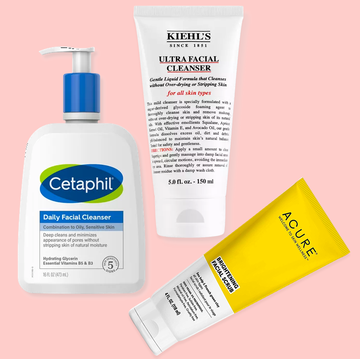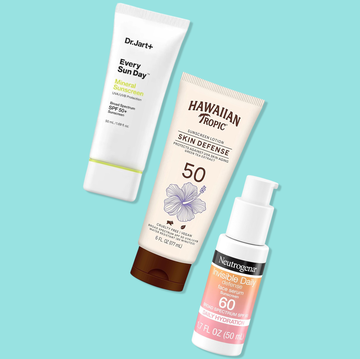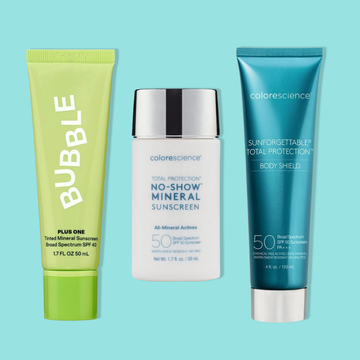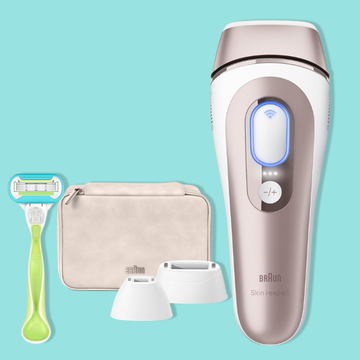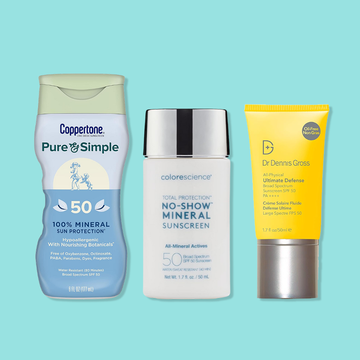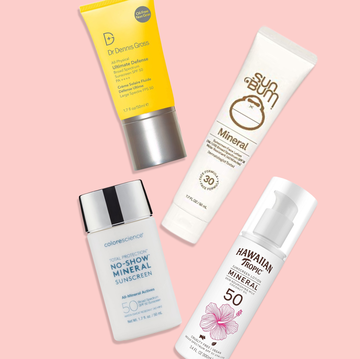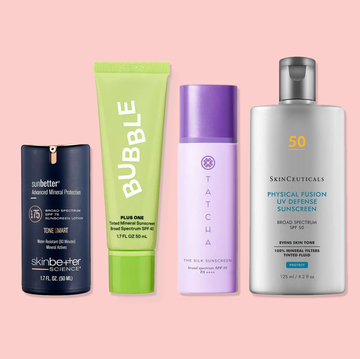If you've ever experienced unwanted discoloration on your face or body, you've probably wondered exactly what causes it and what to do about it but most importantly, what exactly it is. Hyperpigmentation and melasma are the two main skin conditions responsible for discoloration, and though they are not the same, the terms dark spots, age spots, pigmentation, hyperpigmentation and melasma are sometimes used interchangeably.
That's why we consulted top dermatologists for all of the details, including the causes and best ways to treat and prevent both conditions.
What is hyperpigmentation?
"Hyperpigmentation is a common skin condition in which patches of skin are darker than the surrounding skin," says Hope Mitchell, M.D., a board-certified dermatologist and founder of Mitchell Dermatology Center of NW Ohio in Perrysburg, Ohio. "It occurs when certain cells in the skin called melanocytes produce too much of the pigment called melanin." Think of hyperpigmentation as an umbrella term for many types of discoloration, including spots from sun exposure, acne scarring, inflammation and more. It typically appears as dark patches or spots that leave the skin with an uneven tone.
What exactly is melasma?
"Melasma is a form of hyperpigmentation that's more commonly seen in women and is thought to be triggered by UV exposure, as well as hormonal influences," Dr. Mitchell says. It is commonly referred to as "the mask of pregnancy," as many women experience melasma during that time.
While melasma can affect anyone, people with darker skin tones, including those of Latin, Asian, Indian, Middle Eastern, Mediterranean, and African descent and people with a family history of melasma are more likely to suffer from the condition, Dr. Mitchell explains. "More than 6 million women are estimated to have melasma, while only 10% of melasma sufferers are men," she adds.
How are hyperpigmentation and melasma different?
"The hormonal aspect is what differentiates melasma from traditional post inflammatory hyperpigmentation and can make it harder to treat," Dr. Mitchell says. You can usually tell if you have melasma based on its appearance and location: It typically looks like blotchy patches on the face, predominantly on the cheeks, nose, forehead, chin and upper lip. Melasma does sometimes affect your arms, neck and upper back, all areas that can be exposed to light. "That's why most people with melasma notice that their symptoms worsen during the summer months," Dr. Mitchell explains.
Hyperpigmentation, on the other hand, can appear as freckles, sun spots, dark spots or larger dark patches. "It can cover smaller areas on the face or be expansive and cover the face, trunk and or extremities," says Dr. Mitchell.
What causes hyperpigmentation?
"Very often, hyperpigmentation is a sign of sun damage or other dysregulation of pigment production in the skin," explains Julie Russak, M.D., board-certified dermatologist and founder of Russak Dermatology Clinic and Russak+ Aesthetic Center in New York City. "Sometimes it can be due to post-inflammatory causes as well." For example, when you have a cyst on your skin that lingers for too long, the inflammation around the cyst breaks down the inside of the cells, and the cells essentially leak pigment that stains the skin. "People often refer to this as a scar, but it’s usually a purplish dark discoloration that is the consequence of inflammation," she says.
In addition to excessive sun exposure and inflammation, there are other factors that can contribute to hyperpigmentation, Dr. Mitchell says, including:
- Acne
- Hormone changes
- Oral contraceptive use
- Pregnancy
- Certain medications that increase sensitivity to sunlight (including some anticancer drugs)
- Trauma or injury to skin
- Bug bites
What causes melasma?
One of the biggest causes of melasma is hormones, which is why it is so common in pregnancy when women experience a surge of changing hormones. "Although it isn’t exactly clear why yet, melasma and estrogen appear to be linked," Dr. Mitchell says. "It’s thought that estrogen acts on the cells in your skin that produce more pigment and increases the amount of tyrosinase (pigment-forming enzyme) in your body." An increase in estrogen can also make your skin cells more sensitive to the sun. "These changing hormones result in excessive melanin production and, in turn, the dark patches on your skin," she explains.
But hormones aren't the only factor. "Anything that increases blood flow to the skin can flare up melasma," says Dr. Russak. Here are some examples:
- Inflammatory conditions
- Genetic predisposition
- UV radiation (a.k.a. sun exposure)
- Infrared radiation
- Heat
How can you treat hyperpigmentation at home?
The right skincare treatments can make a world of a difference. "Products are typically divided into hydroquinone vs. non hydroquinone products," says Dr. Jackson. Some of her patients start with prescription strength hydroquinone (HQ) for a few months and then maintain improvement with non-hydroquinone products that include the ingredients listed above. While others will start with the non-hydroquinone group.
"Hydroquinone inhibits the production of melanin, breaks up melanosomes that store and transfer melanin into the skin, and destroys melanocytes that produce melanin," says Dr. Mitchell. She notes that this strong chemical ingredient may cause irritation, post inflammatory hypopigmentation [pigment loss] or ochronosis (a deposition of gray pigment in the skin) with long term use, so you may want to check with your dermatologist before using. Use them alone or as directed by your dermatologist: Dr. Jackson recommends using hydroquinine products twice daily.
When it comes to non-hydroquinone skincare products, "you want to use products that boost cellular turnover and that contain actives that treat skin discoloration," Dr. Mitchell advises. Meaning, it's all about key ingredients. Here are some powerful ones to look for in products like serums and creams to help fade and remove hyperpigmentation spots:
- Vitamin C stimulates collagen production, brightens the skin and boasts strong antioxidant properties. It reduces hyperpigmentation by blocking melanin production. Dr. Jackson recommends vitamin C daily, and it can be used in conjunction with other ingredients.
- Kojic acid. Produced by fungi and a byproduct of fermentation, "this acid works similarly to vitamin C as it also reduces hyperpigmentation by inhibiting tyrosinase enzymes that cause melanin production," Dr. Mitchell says. It can be used once to twice daily.
- Retinoids. A form of vitamin A and a go-to ingredient to treat hyperpigmentation, retinoids encourage cell turnover and reduce melanosome transfer, bringing healthier, newer skin cells to skin's surface while getting rid of older, darker ones. Dr. Mitchell recommends using retinoids daily, separate from other exfoliating skincare ingredients.
- Niacinamide, a form of vitamin B3, inhibits melanosome transfer (with melanin) to skin cells. It's generally safe to use alongside other skincare products and safe for use once to twice daily.
- Azelaic acid "has anti-inflammatory properties and can suppress melanin production," Dr. Mitchell says. The gentler ingredient is a good option for pregnant women who are experiencing hyperpigmentation and can be used twice daily alongside other skincare ingredients, even if you have sensitive skin.
- Mandelic acid is an alpha-hydroxy acid (AHA) typically used in chemical peels, but it can also be found in over-the-counter skincare products. "A small study found that a biweekly chemical peel of mandelic acid reduced post-inflammatory hyperpigmentation more effectively than other ingredients like glycolic acid or phytic acid," Dr. Mitchell notes. It can be used once to twice daily, but be careful when pairing exfoliating ingredients with retinoids or other chemical ingredients.
- Arbutin. Derived from the bearberry plant or pear tree leaves, arbutin is a natural derivative of hydroquinone that prevents melanin formation. This ingredient is "typically seen blended into products (sometimes with a few other brightening ingredients) and can be used once or twice daily."
- Soy. Another natural option, "soy inhibits UVB-induced pigmentation and is great for blotchiness and mottled pigmentation," Dr. Mitchell explains. Often incorporated in other skincare ingredients, it's generally safe to use once to twice daily.
- Glycolic acid. This potent AHA helps to loosen the bonds in the top layer of the skin, helping to remove some discoloration and assisting in improved product penetration. It can be applied twice daily in concentrations up to 10%, but be careful when pairing it with other skincare ingredients that exfoliate to avoid irritation.
- Cysteamine. Found in its highest concentration in human milk, cysteamine is a newer ingredient in the market for treating hyperpigmentation when blended with niacinamide.
Always follow up with sunscreen for best results and to prevent future hyperpigmentation. "It may take take 8-12 weeks of consistent use of any of these ingredients to see improvement," says Dr. Jackson.
How can you treat hyperpigmentation with a dermatologist?
There are multiple different options of professional treatments for more stubborn hyperpigmentation, depending on the cause. "Everyone’s skin is different and we create customized protocols for each patient’s needs," says Dr. Russak. "With all of these treatments you see results after each one, and they get better as you continue treatment, and as time passes you will see more long term results."
Both derms agree that professional treatments should always be paired with a comprehensive skincare routine at home, including sunscreen to enhance, protect and maintain results.
- "Resurfacing lasers often work great for hyperpigmentation, starting with Clear + Brilliant, specifically the Permea handpiece," Dr. Russak says. "While it decreases hyperpigmentation, Permea also helps to deliver active ingredients in brightening skincare products into the skin to improve the results without the risk of post inflammatory hyperpigmentation." Generally, she recommends between three to five sessions of laser treatments (more info below) as an initial series.
- Fractional laser resurfacing and erbium laser resurfacing are Dr. Russak's recommendation for sun damage and age-related hyperpigmentation. "For sun spots, IPL (Intense Pulsed Light) is one of the most well-known and effective treatments," Dr. Russak says. "You can usually see results two weeks after laser treatments," she explains.
- Dermaplaning, a treatment that helps with exfoliation, is a favorite treatment of Dr. Mitchell's. "Removing dead skin cells allows for the best penetration of skincare that is targeted to treat the hyperpigmentation," she says. This can be done every four to six weeks separately from laser treatment or in conjunction, advises Dr. Mitchell. "Depending on the depth and extent of the hyperpigmentation, it’s best to plan on having at least three treatments to see improvement."
- Chemical peels can help with cellular turnover and microneedling, Dr. Mitchell says, is "a fantastic way to lighten pigmentation with an added bonus of some fine line reduction or minimizing of acne scarring in some cases." As with dermaplaning, these procedures can be done every four to six weeks separate from or in addition to laser treatments. Expect results after at least three sessions.
How can you treat melasma at home?
The right skincare treatments make all the difference. Here's what to look out for:
- Hydroquinone—which is found in both over-the-counter products at 2-3% or as a prescription when 4% or above— can be used "as a short booster treatment for melasma," says Dr. Russak "and then we move onto creams that decrease pigment production, decrease inflammation in the skin and help to increase cellular turnover to remove cells that already contain pigment from melasma and to produce newer, healthier cells." Derms recommend using it for three to six months under the guidance of your doctor, and then take a three month break to allow your skin to rest. Steer clear of other brightening ingredients while using it.
- Azaleic acid "calms down inflammation in the skin such as acne and rosacea which can often lead to hyperpigmentation, and specifically melasma, and it has a direct effect on reducing the activity of melanocytes," explains Dr. Russak. It can be used daily and should yield results in 8-12 weeks, and can be used (and the effects may even be enhanced) alongside glycolic acid and retinoids.
- Kojic acid, blocks tyrosinase, which is needed to produce melanin in the skin, therefore preventing pigment formation. It can be used once to twice daily (depending on your skin), is safe to use with other skincare ingredients and should also provide results in 8-12 weeks of consistent use.
- Vitamin C is a powerful antioxidant that protects against free radical damage in the skin that leads to pigmentation and naturally brightens the skin. It's recommended to use once daily, the results should show in a similar timeframe to the other ingredients (8-12 weeks), and can be combined with retinoids, as both stimulate collagen production.
- An AHA, like glycolic acid, will help prepare skin for the next steps of your skincare routine, which is why Dr. Mitchell suggests starting your skincare routine with a cleanser that contains AHAs. Some may be able to use daily in the form of a cleanser, cream or lotion while more sensitive skin should stick with two to three times weekly. Depending on your skin type and sensitivity, it can be used in conjunction with other melasma-fighting ingredients.
What are some dermatologist fixes for melasma?
- Prescription products, like tretinoin and corticosteroids, which are compounded hydroquinone products with a retinoid and corticosteroid to aid in controlling the inflammation triggered by hormones and heat, says Dr. Mitchell. "This is often called a triple cream, as it may contain hydroquinone, tretinoin, and a corticosteroid in one cream," she says. It is recommended to be used daily, typically in the evening, and depending on the depth or darkness of pigmentation, results may take 12-16 weeks.
- Lasers, like Clear + Brilliant, which "is one of the lightest lasers that uses low energy technology and is great for the specific hyperpigmentation caused by melasma," Dr. Russak says. She typically recommends a series of five sessions, two weeks apart and shares that the results are both immediate as well as continuous. "Days after the treatment your skin will look brighter and more even, and will begin feeling softer," she adds. "With a series of treatments, pigment reduction increases, your skin will build collagen and will feel tighter, pores will appear smaller, and overall skin tone and texture will improve."
- A prescription oral remedy, tranexamic acid. “This medication is typically used to treat menorrhagia or heavy periods. but can be added as a short term treatment for melasma, as it can help reduce melanin synthesis,” explains Dr. Mitchell. “You could potentially see improvement in your skin after taking it for one to two months.”
How can you prevent hyperpigmentation?
It's all about sun protection. Dr. Mitchell suggests avoiding direct sunlight and heat, especially during the peak hours of 10 a.m. to 2 p.m.. "Sit under a sun umbrella or in the shade when you’re outdoors to minimize your sun exposure," she says. Always apply SPF—look for at a broad spectrum sunscreen that is at least SPF 30 and use it daily, even in the winter months to protect your skin from harmful UV rays. In addition to sunscreen, which Dr. Russak agrees is "the best prevention out there," she suggests using AHAs, BHAs and retinol to regenerate and renew cells on the surface, which can prevent pigment from setting in.
Derm tips for hyperpigmentation prevention: Minimize touching, scratching, or picking at skin, which "can exacerbate already existing inflammation and lead to darker pigmentation on your face," says Dr. Mitchell. "When you do touch your skin ... make sure you wash your hands first."
How can you prevent melasma?
Being fastidious about applying sunscreen daily, even when you are indoors, is the number one way to prevent melasma. "Exposure to UV radiation and hormonal surges are big triggers, but sitting in front of the computer or tablet for a very long time and being exposed to blue light can also exacerbate melasma," Dr. Russak adds. For added protection, apply a serum with antioxidants like vitamins C and E before your sunscreen or try a skincare product with blue light protection, like Payot Blue Techni Liss Day Cream.
Derm tips for melasma prevention: Avoid hormone treatments, specifically ones that involve estrogen, makeup or skincare that irritates your skin, scented soaps, tanning beds and waxing, all of which can exacerbate melasma, says Dr. Mitchell.
Dori Price is a New York City-based freelance writer and editor and beauty, style and wellness expert who was the Beauty & Fashion Director at Family Circle for 13 years before she joined Good Housekeeping, Prevention and Woman’s Day as a freelance beauty editor. She has also written for WomensHealthMag.com, Elle.com and HealthCentral.com.


